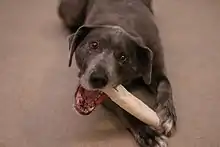
A chew toy is a toy designed to be chewed by animals for stimulation, boredom and relief.[1] In young animals, such as puppies, chew toys can help relieve pain associated with teething.[2] There are several types of chew toys made from materials including rawhide, wood, paper, and mineral. Chew toys are commonly associated with dogs, but have been effective with birds, rodents, and rabbits.
Besides providing entertainment, chew toys can help an animal relieve anxiety and discourage destructive behaviors.[2] For example, providing pigs with chew toys as a form of environmental enrichment has been shown to reduce instances of tail-biting.[3] Some laws surrounding pig production within the European Union include chew toys under the umbrella of 'manipulation materials' that are required by law to be provided to pigs to facilitate necessary 'proper investigation and manipulation activities'.[4]
Chew toys can also help maintain healthy teeth and gums.[5] Some domestic animals, such as rabbits and hamsters, specifically require chew toys in order to maintain their oral health as their teeth grow continuously throughout their life and must be whittled down by extensive chewing on suitable materials in order to maintain them at a functional length.[6]
Human infants are given a similar toy called a teether, to help soothe inflamed gums during teething.
Rawhide

Rawhide chew toys are among the most popular chew toys for dogs. Since rawhides are made of hard and durable material, these toys can sometimes withstand weeks of wear before they are rendered unusable. Examples of rawhide chew toys are twists and rawhide bones.
Rawhide's safety is contested, with groups such as the American Kennel Club advising that large chunks of rawhide can cause intestinal blockages when ingested.[7] Chew toys made of leather are not recommended for dogs as they cannot be properly digested in the stomach, and risk causing intestinal obstruction.[8]
Wooden
Wooden chew toys are made of soft, non-poisonous wood, and are often coated in bright, vegetable-based dyes or paints. They are generally used by rabbits and small rodents.
Paper
Paper chew toys are made of non-bleached, non-toxic paper. They are often inexpensive or able to be crafted at home. One common paper chew toy is an empty toilet paper tube.
Mineral
Mineral chew toys are made of flavored animal-safe minerals. These range from flavored fruit-shaped blocks for birds to ice cream cone-shaped treats for rabbits. They also come shaped like bowls with minerals inside. A common mineral chew toy is the cuttlebone, a toy for birds that aids in trimming nails and beaks.
Rubber

There are a variety of rubber chew toys for dogs on the market that are molded into different shapes. Some are hollowed so that treats can be placed in them. These chew toys sometimes contain materials that are unsafe for dogs to ingest, such as polyvinyl chloride.
References
- ↑ US patent 5477815, Anthony O'Rourke, "Dog chew toy", issued 1995-12-26
- 1 2 "How to Prevent Puppy Chewing Problems". Thriving Canine. 2013-02-07. Retrieved 2020-01-12.
- ↑ "Providing Enrichment For Pigs" (PDF). Compassion in World Farming. 2011-07-11. Retrieved 2023-05-09.
- ↑ "On best practices with a view to the prevention of routine tail-docking and the provision of enrichment materials to pigs" (PDF). European Commission. 2016-08-03. Retrieved 2023-05-09.
- ↑ Lynn Smith, Chandra (2009-04-19). "Use chew toys, leash to help train puppies". The Evening Sun. Archived from the original on 2009-09-03. Retrieved 2009-05-02.
- ↑ Kruzer, Adrienne (2022-03-08). "What to Do if Your Hamster is Biting Its Cage". The Spruce Pets. Retrieved 2023-05-09.
- ↑ Anna Burke (2023-11-09). "Are Rawhide Chews Dangerous for Dogs?". American Kennel Club. Retrieved 2023-11-20.
- ↑ Parent, Lucia E.; Lucia Roesel-Parent (2003). Beagles: Everything about Purchase, Care, Nutrition, Handling, and Behavior. Barron's Educational Series. p. 23. ISBN 0-7641-2002-6.